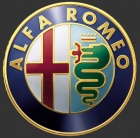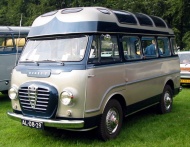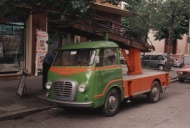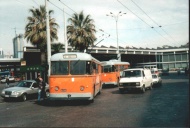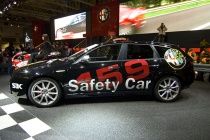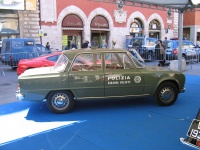Difference between revisions of "Alfa Romeo"
m |
m |
||
| Line 118: | Line 118: | ||
Alfa Romeo is also sponsoring SBK [[Superbike World Championship]] and [[Ducati]] Corse since 2007. The [[Alfa Romeo 159]] Sportwagon TI is used as safety car in Superbike World Championship events. | Alfa Romeo is also sponsoring SBK [[Superbike World Championship]] and [[Ducati]] Corse since 2007. The [[Alfa Romeo 159]] Sportwagon TI is used as safety car in Superbike World Championship events. | ||
| + | ==Alfa Romeo in popular culture== | ||
| + | [[Image:It police alfa giulia 2.jpg|200px|right|thumb|"Panther" Alfa Giulia Super]] | ||
| + | In the [[1960s]] Alfa Romeo became famous for its small cars and models specifically designed for the Italian police — "Panthers" | ||
| + | and [[Carabinieri]]; among them the glorious "Giulia Super" or the 2600 Sprint GT, which acquired the expressive nickname of "Inseguimento" (this car is wrongly supposed to be the one that the famous Roman police marshal and unrivalled driver Armandino Spadafora brought down on the Spanish Steps in 1960 while following some robbers - it was actually a black Ferrari 250 GT/E - this picture of Giulia [http://www.alfaclubdc.com/suprflm3.jpg], one of the dozens about this legend, is taken from a movie and not at the Spanish Steps). | ||
| + | |||
| + | Before being bought by Fiat, Alfa Romeo always had a daring commercial policy, constantly experimenting with new solutions and using them in its series production, even at the risk of losing market share. Alfa often used controversial and unorthodox styling too, which often challenged assumptions about styling. | ||
| + | |||
| + | In a British sales brochure: | ||
| + | :''The Alfa Romeo Giulia 1600 SS - For the man who has everything, here is the car to keep him company. ... The price is [[GBP]] 2394.1.3 including tax. Expensive? Naturally! What else would you expect a hand-built Alfa to be?'' [http://web.archive.org/web/20051026205238/http://www.geraldo.at/SS/sales/SS_sales_C1.jpg] | ||
| + | |||
| + | It represented those makes of cars that permitted sporty driving on common roads, provided the driver was enthusiastic enough to appreciate their particular "sound". | ||
| + | |||
| + | In Italian the owner of an Alfa Romeo is an "[[Alfista]]", and a group of them are "Alfisti". Alfa Romeo is sometimes worshipped by its owners, and many models have become cultural symbols. There are many thriving Alfa Romeo owners clubs and [[Alfa Romeo Model Register]]s. | ||
| + | <!-- Commented out because image was deleted: [[Image:GraduateSpider.jpg|200px|thumb|right|[[Dustin Hoffman|Dustin Hoffman's]] | ||
| + | Spider runs out of gas in ''[[The Graduate]].'' | ||
| + | In 1967 the famous [[Dustin Hoffman]] film ''[[The Graduate]]'' gave worldwide unforgettable celebrity to the "[[Alfa Romeo Spider|Spider]]" (best known by the Italian nickname of "Duetto", or as "Osso di Seppia," meaning "cuttlefish bone," or Round-tail), and its unique shape [http://hem.passagen.se/veloce/wpe28.jpg]. | ||
| + | The Spider was designed by [[Pininfarina]]; derived from several design studies dating back to the late 1950s, the Spider is believed to be the last design on which [[Battista Farina]] personally worked. | ||
| + | |||
| + | Also James Bond (Roger Moore) used an Alfa Romeo, the [[Alfa Romeo Alfetta#GT.2C GTV and GTV6|GTV6]] in 1983's ''[[Octopussy]]'', where he is pursued by two Bavarian BMW police cars. | ||
| + | |||
| + | In the television crime film series ''[[Ein Fall für Zwei]]'' ("a case for two", over 250 episodes made so far), the leading actor [[Claus Theo Gärtner]], who plays the role of the private detective Josef Matula, has always been driving Alfa Romeo, starting from Giulia Super to the latest Alfa Romeo models. | ||
| + | |||
| + | Alfa Romeo had also "role" in other German detective serie ''[[Kommissar Rex]]'' (Inspector Rex). At the beginning [[Tobias Moretti]] drove a 155 and later [[Gedeon Burkhard]] drove 166. | ||
| + | |||
| + | Michael Corleone (Al Pacino) in ''[[The Godfather]]'', drove a magnificent, black [[Alfa Romeo 6C]] while in exile in Sicily. This was actually the car that was booby-trapped and explodes with Apollonia, his Sicilian wife, in it toward the end of the movie. | ||
| + | |||
| + | John Malkovich, as Tom Ripley, in ''[[Ripley's Game (film)|Ripley's Game]]'', drives a red [[Alfa Romeo 156]] Sportwagon. | ||
| + | |||
| + | [[Edward Fox (actor)|Edward Fox]], as the Jackal, in 1973's ''[[The Day of the Jackal (film)|The Day of the Jackal]]'' drives a white [[Alfa Romeo Giulietta|Giulietta Spider]]. He repaints the car blue in a rented garage to avoid police, then crashes the car. | ||
| + | |||
| + | [[Giulietta Masina]] in [[Federico Fellini|Fellini's]] ''[[Juliet of the Spirits]]'' is courted by a "Romeo" in a [[Alfa Romeo Giulietta|Giulietta (Spider)]], a double play on words. | ||
| + | |||
| + | Alfa Romeo Giulias appear as Polizia cars in the 1969 movie ''[[The Italian Job]]''. During the chase in [[Turin]] they all suffer some sort of fate, from breaking down on top of a building to being washed away by a weir. | ||
| + | |||
| + | Alfa Romeo motorcars are recognised by all Motor enthusiasts as being the first "supercar", with the term being coined in the 1920s by a British journalist to describe an Alfa Romeo. Some notable owners include [[Beppe Carletti]] (Musician, Retailer), [[Jeremy Christian]] (Classic Track Driver, Writer), [[Jeremy Clarkson]] (Motoring Journalist), [[Alex Hucksley]] (Actor, Stock Broker), [[Roger Moore]] (Actor) and [[Michael Schumacher]] (F1 Driver). | ||
| + | |||
| + | In [[Dan Brown]]'s novel ''[[Angels & Demons]]'', the members of the [[Swiss Guard]] all drive Alfa Romeo sedans. | ||
Revision as of 23:29, 29 June 2008
Alfa Romeo is an Italian automobile manufacturing company, founded as "Darracq Italiana" by Cavaliere Ugo Stella, an aristocrat from Milan in partnership with the French automobile firm of Alexandre Darracq. The partnership refurbished an idle Darracq factory in Portello, a Milan suburb, but at the onset of World War I the company converted to a munitions factory and the partnership was dissolved.
Alfa Romeo has been a part of Fiat SpA since 1987. The company was originally known as ALFA, which is an acronym meaning Anonima Lombarda Fabbrica Automobili. (First logo: [1])
When Nicola Romeo, engineer industrialist, bought ALFA in 1915, his surname was appended to the company name. Within a few years of Nicola Romeo taking control, the company began to participate in Grand Prix motor racing.
The company's first automobile was the 24hp, which appeared in 1910, and the following year entered the Targa Florio, the special competition in Sicily.
In 1928 Nicola Romeo left, with Alfa going broke after defense contracts end, and in 1933 Alfa Romeo was rescued by the government, which then had effective control. Alfa became an instrument of Mussolini's Italy, a national emblem. The Alfa factory was bombed during World War II, and struggled to return to profitability after the war. The luxury vehicles were out. Smaller mass produced vehicles began to issue from Alfa's factories. By the seventies, Alfa is again in financial trouble, and the Italian government bows out in 1986, as FIAT buys in, creating a new group, Alfa Lancia Spa, to manufacture Alfas and Lancias.
Racing history
Main Article: Alfa Romeo in motorsport

Alfa Romeo scored many prestigious victories in all the different categories: Formula 1, Prototypes, Touring and Fast Touring. Private drivers also ran some rally competitions with fine results.
In 1923 Vittorio Jano was lured to Alfa from Fiat, designing the motors that gave Alfa racing success into the late thirties. (When Alfa began to lose in the late thirties Jano was promptly sacked.)
In the 1930s, Tazio Nuvolari won the Mille Miglia in a 6C 1750 [2], crossing the finishing line after having incredibly overtaken Achille Varzi without his lights (at nighttime).
The 8C 2300 won the Le Mans 24 Hours from 1931 to 1934, with Alfa Romeo withdrawing from racing in 1933, when the Italian government took over, and the racing of Alfas was then taken up by Scuderia Ferrari as Alfa's outsourced team. (Enzo Ferrari drove for Alfa, before he went on to manage the team, and after that, went on to manufacture his own cars.) In 1935 Alfa Romeo won the German Grand Prix with Nuvolari. In 1938 Biondetti won the Mille Miglia in a 8C 2900B Corto Spyder, thereafter referred to as the "Mille Miglia" model.
In 1950 Nino Farina won the Formula One World Championship in a 158 with compressor, in 1951 Juan Manuel Fangio won while driving a Alfetta 159 (an evolution of the 158 with a two-stages compressor). Other titles won in 1975 and 1977, while the 33 dominated the Prototype category from 1967 to 1977.
In the 1960s Alfa Romeo became famous for its small cars and models specifically designed for the Italian police ("Panthers") and Carabinieri; among them the glorious "Giulia Super" - [3]. Or the 2600 Sprint GT [4], which obtained an expressive nickname of "Inseguimento" (this car is wrongly supposed to be the one that the famous Roman police marshall and unrivalled driver Armandino Spadafora brought down on the Spanish Steps in 1960 while following some robbers - it was instead a black Ferrari 250 GT/E - this pic of Giulia [5], one of the dozens about this legend, is taken from a movie and not at Spanish Steps).
After the 1970s, economic issues caused the government to finally sell Alfa Romeo to Fiat in 1986, which still own it.
Before being bought by Fiat, Alfa Romeo always had a daring commercial policy, constantly experimenting with new solutions and using them in its series production, even at the risk of losing market share. Alfa often used controversial and unorthodox styling too, which often challenged one's assumptions about styling.
On an English sales brochure:
- The Alfa Romeo Giulia 1600 SS - For the man who has everything, here is the car to keep him company. ... The price is GBP 2394.1.3 including tax. Expensive? Naturally! What else would you expect a hand-built Alfa to be? [6]
It represented the make of those cars which could allow some sporty driving on common roads, provided the driver was enthusiast enough to appreciate their particular "sound".
One owner of an A.R. is an "Alfista", and a group of them are "Alfisti", in Italian. Alfa Romeo is sometimes worshipped by its owners, and many models have become cultural symbols. There are many thriving Alfa Romeo owners clubs and Alfa Romeo Model Registers.
In 1967 the famous Dustin Hoffman's film "The Graduate" gave worldwide unforgettable celebrity to the "Spider" (best known with the Italian nickname of "Duetto", or as "Osso di Seppia" or Round-tail), and its unique shape. The Spider was designed by Pininfarina.
RHD Alfa Romeo Production post-1960
In the late 1960's, a number of European automobile manufacturers established facilities in South Africa to assemble right hand drive vehicles for the Commonwealth markets. Fiat and other Italian manufacturers established factories along with these other manufacturers in Rosslyn, Pretoria and later in Brits.
With the imposition of sanctions by western powers in the 1970's and 1980's, South Africa became self sufficient, and in car production came to rely more and more on the products of the Uitenhage factories. In consequence, production levels increased, and many manufacturers including Fiat Spa., Lancia, Ferrari and Alfa Romeo transferring all their right-hand drive production to Uitenhage. Volkswagen AG, Daimler Benz AG and BMW AG followed suit at about this time.
Since then, all right-hand-drive production of Alfa Romeo (and most other European manufacturers) remains in Uitenhage - so that RHD European cars are actually South African in origin, or else have their steering and dashboard assemblies produced there.
Production models
Until the 1980s, Alfa Romeos, except for the Alfasud, were rear-wheel-drive.
In 1995 Alfa Romeo ceased exporting cars to the US. While rumours occasionally surface of their intent to return to that market, no formal plans have ever been announced. The most credible is a rumour that, with Maserati's help, the Alfa Romeo 159 and Alfa Romeo Brera will be the make's pilot models should it reenter the North American market.
Cloverleaf or Quadrifoglio badges denote variants of Alfa Romeo cars, where the name denotes the high-end of the range in comfort and engine size, but previously denoted Alfa Romeo racing cars in the pre-second-world-war era. The image first appeared in 1923 when Ugo Sivocci presented one prior to the start of the 14th Targa Florio as a good luck token to the team. This became the symbol of competition Alfas, denoting higher performance. Some modern Alfas wear a cloverleaf badge which is typically a green four leaf clover on a white background (Quadrifoglio Verde), but variants of blue on white have been recently observed. It is assumed that these might denote advanced equipment in other areas (?).
The Alfettas of the early 1980s had models available sold as the "Silver Leaf" and "Gold Leaf" (Quadrifoglio Oro). These models were the top-of-the-range at the time. Badging was the Alfa Cloverleaf in either gold or silver to denote the specification level. The Gold Leaf model was also sold as the "159i" in some markets, the name in homage to the original 159.
The trim levels (option packages) offered today on the various nameplates (model lines) include the lusso, “luxury,” turismo, “touring,” and the GTA (gran tourismo alleggerita, “lightened grand touring”). The GTA package is offered in the 147 and 156 and includes a V-6 engine. In the past, Alfa Romeo offered a Sprint (from Italian sprinta, "tuned") trim level.
Other production
Aircraft engines
An Alfa engine was first used on an aircraft in 1910 on the Santoni-Franchini biplane. In 1932 Alfa Romeo built it's first real aircraft engine the D2 (240 bhp), which was fitted to Caproni 101 D2. In the 1930s when Alfa Romeo engines were used for aircraft on a larger scale; the Savoia Marchetti SM.74, Savoia-Marchetti SM.75, Savoia-Marchetti SM.79, Savoia Marchetti SM.81 and Cant Z506B Airone all used Alfa Romeo manufactured engines. In 1931, a competition was arranged where Tazio Nuvolari drove his Alfa Romeo 8C 3000 Monza against a Caproni Ca.100 airplane. Alfa Romeo built various aircraft engines during World War II; the best known was the RA.1000 RC 41-I Monsone, a licensed version of the Daimler-Benz DB 601. This engine made it possible to build efficient fighter aircraft like the Macchi C.202 Folgore for the Italian army. After World War II Alfa Romeo produced engines for Fiat, Aerfer and Ambrosini. In the 1960s Alfa Romeo mainly focused upgrading and maintaining Curtiss-Wright, Pratt & Whitney, Rolls-Royce and General Electric aircraft engines. Alfa Romeo built also Italy's first turbine engine, installed to the Beechcraft King Air. Alfa Romeo's Avio division was sold to Aeritalia in 1988, from 1996 it was part of Fiat Avio.
Trucks, light commercial vehicles
In 1930 Alfa Romeo presented a light truck in addition to heavy LCVs based to Büssing constructions. In the Second World War Alfa Romeo also built trucks for the Italian army ("35 tons anywhere") and later also for the German Wehrmacht. After the war, commercial motor vehicle production was resumed. In co-operation with FIAT and Saviem starting from the 60s different light truck models were developed. The production of heavy LCVs was terminated in 1967. In Brazil the heavy trucks were built still few years under the name FNM (Fàbrica Nacional de Motores). Last Alfa Romeo vans were Alfa Romeo AR6 and AR8, which were rebadged versions of Iveco Daily and Fiat Ducato. The company also produced trolleybuses, which were used by many cities in Italy. Later, Alfa Romeo concentrated only on passenger car manufacturing.
LCVs
- Romeo (1954-1958)
- Romeo 2 (until 1966)
- Romeo 3 (1966)
- A11/F11
- A12/F12 (until 1983)
- AR8 (based on first generation Iveco Daily)
- AR6 (based on first generation Fiat Ducato)
Trucks
- Alfa Romeo 430 (1942-1950)
- Alfa Romeo 500
- Alfa Romeo 800 (1940-1943)
- Alfa Romeo 900
- Alfa Romeo 950
- Alfa Romeo Mille (Alfa Romeo 1000)
- Alfa Romeo A19n (Saviem license)
Buses
- Alfa Romeo 900
- Alfa Romeo 950
- Alfa Romeo Mille (Alfa Romeo 1000)
Trolleybuses
- Alfa Romeo 110AF (1938)
- Alfa Romeo 140AF (1949)
- Alfa Romeo 900
- Alfa Romeo Mille (Alfa Romeo 1000)
Alfa Romeo sponsorships
In 2002 was launched the first Alfa Romeo super maxi yacht and Neville Crichton's new super maxi Alfa Romeo 2 was first tested in 2005, this 30m ship is successor to the world champion of the same name. The first Alfa Romeo super maxi took around 74 wins, including the 2002 Rolex Sydney Hobart Yacht Race.
Alfa Romeo is also sponsoring SBK Superbike World Championship and Ducati Corse since 2007. The Alfa Romeo 159 Sportwagon TI is used as safety car in Superbike World Championship events.
Alfa Romeo in popular culture
In the 1960s Alfa Romeo became famous for its small cars and models specifically designed for the Italian police — "Panthers" and Carabinieri; among them the glorious "Giulia Super" or the 2600 Sprint GT, which acquired the expressive nickname of "Inseguimento" (this car is wrongly supposed to be the one that the famous Roman police marshal and unrivalled driver Armandino Spadafora brought down on the Spanish Steps in 1960 while following some robbers - it was actually a black Ferrari 250 GT/E - this picture of Giulia [7], one of the dozens about this legend, is taken from a movie and not at the Spanish Steps).
Before being bought by Fiat, Alfa Romeo always had a daring commercial policy, constantly experimenting with new solutions and using them in its series production, even at the risk of losing market share. Alfa often used controversial and unorthodox styling too, which often challenged assumptions about styling.
In a British sales brochure:
- The Alfa Romeo Giulia 1600 SS - For the man who has everything, here is the car to keep him company. ... The price is GBP 2394.1.3 including tax. Expensive? Naturally! What else would you expect a hand-built Alfa to be? [8]
It represented those makes of cars that permitted sporty driving on common roads, provided the driver was enthusiastic enough to appreciate their particular "sound".
In Italian the owner of an Alfa Romeo is an "Alfista", and a group of them are "Alfisti". Alfa Romeo is sometimes worshipped by its owners, and many models have become cultural symbols. There are many thriving Alfa Romeo owners clubs and Alfa Romeo Model Registers.
